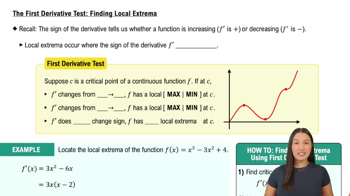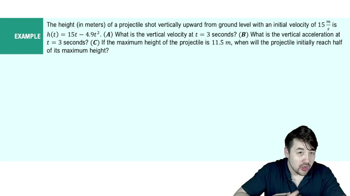{Use of Tech} Graph carefully Graph the function f(x) = 60x⁵ - 901x³ + 27x in the window [-4,4] x [-10,000, 10,000]. How many extreme values do you see? Locate all the extreme values by analyzing f'.
Table of contents
- 0. Functions7h 54m
- Introduction to Functions16m
- Piecewise Functions10m
- Properties of Functions9m
- Common Functions1h 8m
- Transformations5m
- Combining Functions27m
- Exponent rules32m
- Exponential Functions28m
- Logarithmic Functions24m
- Properties of Logarithms36m
- Exponential & Logarithmic Equations35m
- Introduction to Trigonometric Functions38m
- Graphs of Trigonometric Functions44m
- Trigonometric Identities47m
- Inverse Trigonometric Functions48m
- 1. Limits and Continuity2h 2m
- 2. Intro to Derivatives1h 33m
- 3. Techniques of Differentiation3h 18m
- 4. Applications of Derivatives2h 38m
- 5. Graphical Applications of Derivatives6h 2m
- 6. Derivatives of Inverse, Exponential, & Logarithmic Functions2h 37m
- 7. Antiderivatives & Indefinite Integrals1h 26m
- 8. Definite Integrals4h 44m
- 9. Graphical Applications of Integrals2h 27m
- 10. Physics Applications of Integrals 3h 16m
- 11. Integrals of Inverse, Exponential, & Logarithmic Functions2h 31m
- 12. Techniques of Integration7h 41m
- 13. Intro to Differential Equations2h 55m
- 14. Sequences & Series5h 36m
- 15. Power Series2h 19m
- 16. Parametric Equations & Polar Coordinates7h 58m
5. Graphical Applications of Derivatives
The Second Derivative Test
Problem 4.3.5c
Textbook Question
Analyzing Functions from Derivatives
Answer the following questions about the functions whose derivatives are given in Exercises 1–14:
c. At what points, if any, does f assume local maximum or minimum values?
f′(x) = (x − 1)(x + 2)(x − 3)
 Verified step by step guidance
Verified step by step guidance1
To find the points where the function f assumes local maximum or minimum values, we need to identify the critical points. Critical points occur where the derivative f'(x) is equal to zero or is undefined. In this case, f'(x) = (x - 1)(x + 2)(x - 3) is a polynomial, so it is defined everywhere. Set f'(x) = 0 to find the critical points.
Solve the equation (x - 1)(x + 2)(x - 3) = 0. This equation is satisfied when any of the factors is zero. Therefore, the critical points are x = 1, x = -2, and x = 3.
Next, determine whether each critical point is a local maximum, local minimum, or neither. This can be done using the First Derivative Test. Evaluate the sign of f'(x) around each critical point.
Choose test points in the intervals determined by the critical points: (-∞, -2), (-2, 1), (1, 3), and (3, ∞). For each interval, pick a test point and substitute it into f'(x) to determine the sign of the derivative in that interval.
Based on the sign changes of f'(x) around each critical point, conclude whether each point is a local maximum, local minimum, or neither. If f'(x) changes from positive to negative at a critical point, it is a local maximum. If f'(x) changes from negative to positive, it is a local minimum. If there is no sign change, the point is neither.
 Verified video answer for a similar problem:
Verified video answer for a similar problem:This video solution was recommended by our tutors as helpful for the problem above
Video duration:
6mPlay a video:
Was this helpful?
Key Concepts
Here are the essential concepts you must grasp in order to answer the question correctly.
Critical Points
Critical points of a function occur where its derivative is zero or undefined. These points are potential locations for local maxima or minima. To find them, set the derivative equal to zero and solve for x. In this case, f′(x) = (x − 1)(x + 2)(x − 3) = 0, so the critical points are x = 1, x = -2, and x = 3.
Recommended video:

Critical Points
First Derivative Test
The First Derivative Test helps determine whether a critical point is a local maximum, minimum, or neither. By analyzing the sign changes of the derivative around the critical points, we can infer the behavior of the function. If f′ changes from positive to negative at a critical point, it's a local maximum; if it changes from negative to positive, it's a local minimum.
Recommended video:

The First Derivative Test: Finding Local Extrema
Sign Analysis of Derivative
Sign analysis involves examining the intervals between critical points to determine the sign of the derivative. This helps in understanding the function's increasing or decreasing behavior. For f′(x) = (x − 1)(x + 2)(x − 3), evaluate the sign of f′ in intervals like (-∞, -2), (-2, 1), (1, 3), and (3, ∞) to apply the First Derivative Test effectively.
Recommended video:

Derivatives Applied To Acceleration Example 2

 6:02m
6:02mWatch next
Master The Second Derivative Test: Finding Local Extrema with a bite sized video explanation from Patrick
Start learningRelated Videos
Related Practice
Textbook Question
